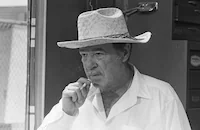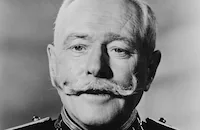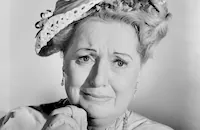The Doolins of Oklahoma
Brief Synopsis
Cast & Crew
Gordon Douglas
Randolph Scott
George Macready
Louise Allbritton
John Ireland
Virginia Huston
Photos & Videos
Film Details
Technical Specs

Synopsis
In Oklahoma, after the Civil War, conflict between homesteaders and cowboys leads to the formation of outlaw gangs like the James Boys and the Younger Brothers. After U. S. Marshals target the Dalton gang and attack them during a bank robbery, the only member remaining alive is Bill Doolin. Later, in self-defense, Doolin kills Wichita, the man who informed on the Daltons, and is chased by a posse. Doolin evades his pursuers, however, and joins forces with Red Buck, Arkansas Tom Jones, Tulsa Jack Blake, Bitter Creek and Little Bill, who become known as the Doolin Gang. After several months of robbing banks, Doolin splits the take among the gang members and orders them to separate until things cool off. They agree to meet in three months time in the town of Ingalls. Riding just ahead of the pursuing marshals, Doolin hides out in a church in the small town of Claymore. After completing a service, Deacon Burton invites Doolin to join his family for dinner. At first, Doolin turns down the invitation, but when the posse returns, he accepts in order to avoid it. At dinner, he talks with Elaine, Burton's attractive daughter, who speaks so tenderly of the joys of farming that Doolin decides to try it. By the end of the three months, Doolin, using the name Daley, has married Elaine and settled on a farm. When Little Bill returns for him, he explains that he wants to leave the gang. Later, however, two gang members, posing as marshals, reveal Doolin's identity to Elaine, and Burton persuades him to leave town. As time passes, the gang grows increasingly restive. Doolin takes them back to Ingalls for a rest, but an undercover marshal is waiting in town, and fetches the posse. During the ensuing gunfight, Tulsa is killed and Arkansas is captured. Later, Bitter Creek and Red Buck are also killed. Doolin then suggests that he and Little Bill hide out on Doolin's old farm, which he is sure will be deserted. To his surprise, Elaine is still living there, waiting for his return. They decide to leave together for an area between Kansas and Texas that has not been claimed by the government. When the marshal in Claymore sees Elaine buying supplies, he becomes suspicious and investigates. Little Bill warns Doolin and then starts a stampede of wild horses to cover Doolin's escape. Little Bill is killed in the stampede, but Doolin manages to slip into town and meet Elaine. As they talk, he realizes how hard a life on the run will be for her and sends her to her parents. After she rides out of sight, Doolin walks out to meet his death.

Director

Gordon Douglas
Cast

Randolph Scott

George Macready

Louise Allbritton

John Ireland

Virginia Huston

Charles Kemper
Noah Beery Jr.

Dona Drake

Robert H. Barrat

Lee Patrick

Griff Barnett
Frank Fenton
Jock O'mahoney

James Kirkwood
Robert Osterloh
Virginia Brissac
George Chesebro
Hank Patterson
Stanley Blystone
Alan Bridge
Paul E. Burns
Chuck Hamilton
Harry Tyler
Mira Mckinney
Joe Palma
Aleth "speed" Hansen
Vernon Dent
Harry Hayden
Edward F. Dunn

Lloyd Ingraham
Trevor Bardette
Claire Meade
Stanley Andrews
David Clarke
Jack Parker
John Sheehan
Reed Howes
Al Hill
William Haade
George De Normand
Ethan Laidlaw
George Bell
Paul Scardon
Michael Smith
Anne O'neal
Tony Urchel
Tony Taylor
Rose Higgins
Frank O'connor
Shooting Star
Crew
George Brooks
Harry Joe Brown
Yakima Canutt
George Duning
Kenneth Gamet
Frank Goodwin
Charles Lawton Jr.
Charles Nelson
Sam Nelson
Paul Sawtell
M. W. Stoloff
Frank [a.] Tuttle

Photo Collections
Film Details
Technical Specs

Articles
The Doolins of Oklahoma
The Doolins of Oklahoma (1949), however, was made several years before his work with Boetticher. If the teaming with Gordon Douglas a former actor who had cut his directorial teeth with "Our Gang" comedies and would go on to direct a wide variety of genre pictures didn't yield any masterpieces, it nevertheless proved that Douglas and Scott knew how to turn out audience pleasing B movies. In addition to The Doolins of Oklahoma, the duo also scored a minor hit with The Nevadan (1950), before Scott moved on to more notable collaborations with first Andre De Toth and later Boetticher. In The Doolins of Oklahoma, as in many of his Westerns, Scott brings a touch of the rogue to his leading role as an outlaw trying to hang up his guns and turn to farming with his wife. When his old gang members resurface, Scott is drawn back into the life of a fugitive.
The character is based on the real-life Bill Doolin, an Oklahoma-based outlaw and founder of The Wild Bunch (no relation to the 1969 Sam Peckinpah film), a gang that engaged in robbing banks, trains and stagecoaches in the 1890s. Doolin, who had been a member of the infamous Dalton Gang when he was younger, never made any attempt to go straight, despite the revisionist portrayal of him presented in The Doolins of Oklahoma. When he was gunned down by a federal lawman in 1896, he was actually 13 years younger than Scott was when he played him on screen. Doolin turned up again as the lead character of The Cimarron Kid (1952) in the person of war-hero-turned-actor Audie Murphy, directed by Budd Boetticher four years before directing Scott in the first of their seven pictures together. Robert Armstrong also played Doolin in Return of the Badmen (1948) which pitted him against Randolph Scott as the local marshal.
Legendary stuntman Yakima Canutt handled the second unit on The Doolins of Oklahoma,"and between he and director Gordon Douglas they set up an impressive array of action scenes, including a great night-time chase through a narrow mountain passage with Scott and company eluding a posse (led by George Macready, playing a hero part for once) and an intense street shoot-out between the Doolins and the posse." (from The Films of Randolph Scott by Robert Nott). Jock Mahoney, who plays Tulsa Jack Blake in the film and later portrayed Tarzan in two movies, was reputedly the stunt double for Scott in The Doolins of Oklahoma.
Director: Gordon Douglas
Producer: Harry Joe Brown
Screenplay: Kenneth Gamet
Cinematography: Charles Lawton, Jr.
Editing: Charles Nelson
Art Direction: George Brooks
Original Music: George Duning, Paul Sawtel, Marlin Skiles (uncredited)
Cast: Randolph Scott (Bill Doolin), George Macready (Marshall Sam Hughes), Louise Allbritton (Rose of Cimarron), John Ireland (Bitter Creek), Noah Beery, Jr. (Little Bill).
BW-90m.
by Rob Nixon

The Doolins of Oklahoma
Quotes
I sure wish I was one of 'em.- Cattle Annie
But you can't be. All you can do is sit here...and hear that tune play...and watch them leave...and wonder if they're going to come back.- Rose of Cimarron
You're talking about love...I'm talking about cows!- Cattle Annie
Trivia
Notes
The film's working titles were The Great Manhunt, Wild Bill Doolin and $5,000 Reward. Bill Doolin was, as the movie depicts, a member of the Dalton gang who started his own gang when the Daltons were destroyed in the Coffeyville raid in 1892. Doolin's gang, known as The Oklahombres, committed a number of bank and train robberies in Oklahoma before Doolin was captured by sheriff Bill Tilghman. Doolin escaped but was eventually killed by a posse.














